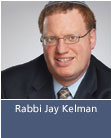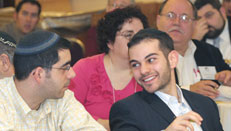 |
||||||||||||
| Weekly Parsha | ||
| Current Week | ||
| Parsha Archives | ||
| Business Ethics | ||
| Dr. Malamet Speaks Out | ||
| TiM MP3 Library | ||




A Thought for the Week with Rabbi Jay Kelman
|
 The central mitzvah associated with Chanukah is the nightly lighting of the menorah. While Jewish law states that only one candle need be lit on each of the eight nights of Chanukah, we have adopted the practice of lighting an additional candle on each successive night, culminating with eight candles on the eighth night. This is based on the opinion of Beit Hillel , the disciples of Hillel, who state that in the performance of mitzvoth, we must be ma'alim bekodesh, we must "go up" in holiness. Beit Shammai , on the other hand, states that the candles should be lit in descending order, so that on the first night, eight candles are lit, decreasing to one on the last night. The Talmud, (see Shabbat 21b) in attempting to explain the basis of the ruling of Beit Shammai, suggests that it is based on the order of the " parei hachag ", the 70 bulls that were brought as sacrifices on Sukkoth. On the first day of Sukkoth, 13 bulls were brought, a number that decreased by one each day; so that on the seventh day, only seven were offered as sacrifices. What, though, is the connection between the sacrifices of Sukkoth and the lighting of the candles on Chanukah? On Chanukah, we celebrate the rededication of the Temple and its role as a unifying force in Jewish life. Interestingly, the original dedication of the Temple by Solomon took place on Sukkoth. The Maccabees saw themselves as restoring our ancient ritual, so it is not surprising that they would look to Sukkoth as a model for the lighting of the candles. Furthermore, they declared that Chanukah, like Sukkoth, should be eight days long, even though the actual miracle of the oil was only seven days. The link between Sukkoth and Chanukah runs much deeper. Our Rabbis teach us that 70 bulls were sacrificed on Sukkoth, corresponding to the 70 nations of the world. On Sukkoth, we stress the universal aspect of Judaism as we share the concerns of the world at large. On Sukkoth, we literally leave our home, the bastion of Jewish values, and live in a home that is exposed to outside elements and influences. It is the time that we celebrate, in conjunction with the nations of the world, the harvest season, by gathering the four species. Chanukah, on the other hand, is the holiday where we resist and if necessary, reject the values of the world around us. The Maccabees, unlike the majority of the Jews living at that time, rejected the culture and world view of Hellenism, a culture that put material values ahead of spiritual ones, that worshipped the body and denigrated the spirit, that created the Olympics but tried to destroy the Beit Midrash . When we light the candles on Chanukah, we reaffirm that we are proud to be part of the "few, weak, and pure" as opposed to the "many, strong, and impure". We are proud to be different from those around us. Yet there is much value in our enemies, and much to be learned from them. We dare not forget that Greek culture and its successors have given much to the world in general and to Judaism in particular. We must imbue the particularistic model of Chanukah with the universal aspects of Sukkoth, and vice versa. |
|
|

 |
 |